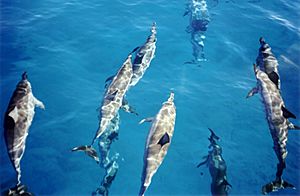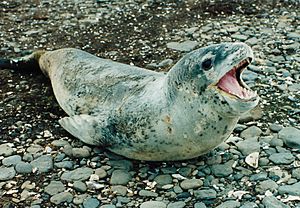List of mammals of the Cook Islands facts for kids
The Cook Islands are a group of islands in the Pacific Ocean. Even though they are small, these islands are home to seven different kinds of mammals! One of these mammals is considered vulnerable, which means it needs our help to survive in the wild.
Scientists use something called a "conservation status" to tell us how much danger an animal species is in. This helps people know which animals need special protection.
Contents
Order: Chiroptera (Bats)
Bats are super cool mammals because they are the only ones that can truly fly! Their front limbs are like wings, helping them soar through the air. About one-fifth of all mammal species are bats.
Family: Pteropodidae (Flying Foxes)
These bats are often called "fruit bats" because they love to eat fruit. They are found in warmer parts of the world.
Genus: Pteropus
- Insular flying-fox, Pteropus tonganus
* This bat is also known as the Pacific flying fox. It's found on many islands in the Pacific, including the Cook Islands.
Order: Cetacea (Whales, Dolphins, and Porpoises)
Cetaceans are mammals that live completely in the water. They include amazing creatures like whales, dolphins, and porpoises. They have sleek, smooth bodies with almost no hair, and their front limbs and tails are shaped to help them swim fast underwater.
Suborder: Mysticeti (Baleen Whales)
Baleen whales don't have teeth. Instead, they have special plates called baleen in their mouths that they use to filter tiny food like krill from the water.
Family: Balaenopteridae
Subfamily: Megapterinae
Genus: Megaptera
- Humpback whale, Megaptera novaeangliae VU
*
* Humpback whales are famous for their long fins and their beautiful songs. They travel long distances between their feeding and breeding grounds. The humpback whale is considered a vulnerable species.
Suborder: Odontoceti (Toothed Whales)
Toothed whales have teeth and are active hunters. This group includes dolphins, porpoises, and many types of whales.
Superfamily: Platanistoidea
Family: Ziphidae (Beaked Whales)
Subfamily: Hyperoodontinae
= Genus: Mesoplodon =
- Ginkgo-toothed beaked whale, Mesoplodon ginkgodens DD
* These whales are quite mysterious and not often seen. They get their name from their unique, ginkgo leaf-shaped teeth. "DD" means there isn't enough data to know their conservation status.
Family: Delphinidae (Marine Dolphins)
These are the well-known dolphins that live in the ocean. They are very smart and social animals.
Genus: Stenella
- Spinner dolphin, Stenella longirostris
* Spinner dolphins are known for their amazing acrobatic leaps and spins out of the water. They often live in large groups.
Genus: Lagenodelphis
- Fraser's dolphin, Lagenodelphis hosei DD
* Fraser's dolphins are also a bit of a mystery, living in deep ocean waters. They have a distinctive stripe along their sides.
Genus: Feresa
- Pygmy killer whale, Feresa attenuata DD
* Despite their name, pygmy killer whales are actually a type of dolphin. They are smaller than true killer whales but are still powerful predators.
Order: Carnivora (Carnivores)
Carnivores are an order of mammals that mostly eat meat. They have special teeth and skulls that help them hunt and eat their prey.
Suborder: Caniformia
This group includes dog-like carnivores, but also seals and bears.
Family: Phocidae (Earless Seals)
Earless seals, also called true seals, don't have external ear flaps like sea lions do. They are very good swimmers.
Genus: Hydrurga
- Leopard seal, Hydrurga leptonyx
*
* Leopard seals are large, powerful predators found in the cold waters around Antarctica. They are known for their spotted coats and their ability to hunt penguins and other seals.
See also
- List of chordate orders
- Lists of mammals by region
- List of prehistoric mammals
- Mammal classification
- List of mammals described in the 2000s



